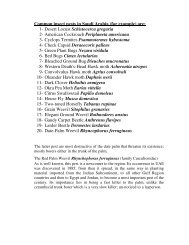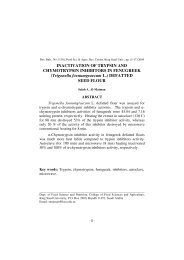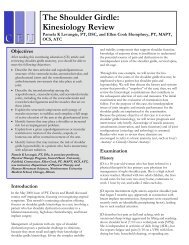abstract - KSU
abstract - KSU
abstract - KSU
You also want an ePaper? Increase the reach of your titles
YUMPU automatically turns print PDFs into web optimized ePapers that Google loves.
Animal Science Journal (2012)<br />
doi: 10.1111/j.1740-0929.2011.00993.x<br />
ORIGINAL ARTICLE<br />
Regional and circadian variations of sweating<br />
rate and body surface temperature in camels<br />
(Camelus dromedarius)asj_993 1..6<br />
Khalid A. ABDOUN, Emad M. SAMARA, Aly B. OKAB and Ahmed A. AL-HAIDARY<br />
Department of Animal Production, College of Food and Agricultural Sciences, King Saud University, Riyadh,<br />
Kingdom of Saudi Arabia<br />
ABSTRACT<br />
It was the aim of this study to investigate the regional variations in surface temperature and sweating rate and to visualize<br />
body thermal windows responsible for the dissipation of excess body heat in dromedary camels. This study was conducted<br />
on five dromedary camels with mean body weight of 450 20.5 kg and 2 years of age. Sweating rate, skin and body<br />
surface temperature showed significant (P < 0.001) circadian variation together with the variation in ambient temperature.<br />
However, daily mean values of sweating rate, skin and body surface temperature measured on seven regions of the camel<br />
body did not significantly differ. The variation in body surface temperature compared to the variation in skin temperature<br />
was higher in the hump compared to the axillary and flank regions, indicating the significance of camel’s fur in protecting<br />
the skin from daily variation in ambient temperature. Infrared thermography revealed that flank and axillary regions had<br />
lower thermal gradients at higher ambient temperature (T a) and higher thermal gradients at lower T a, which might indicate<br />
the working of flank and axillary regions as thermal windows dissipating heat during the night. Sweating rate showed<br />
moderate correlation to skin and body surface temperatures, which might indicate their working as potential thermal<br />
drivers of sweating in camels.<br />
Key words: camel, infrared thermography, surface temperature, sweating rate, thermal window.<br />
INTRODUCTION<br />
In camels, sweat glands are distributed over nearly the<br />
entire body except the lips, external nares and perianal<br />
region (Lee & Schmidt-Nielsen 1962; Taha & Abdalla<br />
1980). Several studies have shown a regional anatomical<br />
difference in sweat gland density of relative species.<br />
The guanaco showed higher densities of sweat glands<br />
around the shoulder, lower part of the upper limb and<br />
lower flank (Morrison 1966; de Lamo et al. 2001).<br />
However, no difference in distribution or number of<br />
sweat glands was found in samples taken from both<br />
genders of guanaco at different times of the year. It has<br />
been demonstrated that the axillary and flank regions<br />
which are covered with very short and sparse pelage<br />
are potentially more effective in evaporative heat dissipation<br />
in guanaco (Morrison 1966).<br />
The major transport mechanism for controlling heat<br />
loss in camels seems to be the convective mechanism<br />
of cutaneous blood flow (Al-Haidary 2006). Exposure<br />
of camels to high ambient temperature (T a) would lead<br />
to an increase in cutaneous blood flow due to peripheral<br />
vasodilatation. Thereby, blood is shifted all over<br />
camel’s body to create a thermal gradient between the<br />
body and the external environment. Surface temperature<br />
is normally used as a reflex index of body thermal<br />
gradient (Curtis 1983). Local superficial venous circulation<br />
is the main source of surface temperature<br />
(Cameron et al. 2004). Vasomotor tone of peripheral<br />
blood vessels in specialized heat exchanger regions<br />
depends on the surrounding T a (Tattersall et al. 2009;<br />
Weissenbock et al. 2010).<br />
Controlling surface temperature is an important<br />
mechanism in temperature regulation of homeotherms<br />
(Phillips & Heath 1992). The major mechanism<br />
of sensible heat loss is cutaneous vasodilatation<br />
in specialized body regions which serves as a heat<br />
Correspondence: Khalid A. Abdoun, Department of Animal<br />
Production, College of Food and Agriculture Sciences, King<br />
Saud University, PO Box 2460, Riyadh 11451, Kingdom<br />
of Saudi Arabia. (Email: abdounn@yahoo.com; kabdoun@<br />
ksu.edu.sa)<br />
Received 20 June 2011; accepted for publication 26 September<br />
2011.<br />
© 2012 The Authors<br />
Animal Science Journal © 2012 Japanese Society of Animal Science
2 K. A. ABDOUN et al.<br />
exchanger with the environment. Such specialized<br />
regions are characterized by high surface-to-volume<br />
ratio, absence of fur, dense network of blood vessels<br />
and the presence of arteriovenous anastomoses<br />
(Wright 1984; Romanovsky et al. 2002; Mauck et al.<br />
2003). The term ‘thermal window’ has been applied<br />
to describe these regions (Williams 1990; Klir & Heath<br />
1992). Later, the term ‘thermal window’ has referred<br />
to any surface area of the body that is responsible<br />
for efficient heat exchange (Sumbera et al. 2007).<br />
Recently, thermal window has been defined as a<br />
restricted surface area which is visible as a hot spot in<br />
a thermal vision and differs by more than 5 o C from its<br />
adjacent regions (Weissenbock et al. 2010).<br />
The thermal camera is considered a state-of-theart<br />
device. It absorbs infrared radiation and generates<br />
images based on the amount of heat generated rather<br />
than reflected (Eddy et al. 2001; Mazur & Eugeniusz-<br />
Herbut 2006). Infrared thermography (IRT) has been<br />
successfully used to visualize body thermal windows<br />
on animal surfaces (Mauck et al. 2003; Tattersall et al.<br />
2009; Weissenbock et al. 2010). IRT may also have<br />
merit for assessing welfare (Stewart et al. 2005), resulting<br />
from changes in body surface temperature associated<br />
with adaptation to microclimate changes<br />
(Kimmel et al. 1992; Knizkova et al. 1996; 2002).<br />
Exchanging body heat with the surrounding environment<br />
through thermal windows is achieved by<br />
modifying blood flow in these regions via controlling<br />
vasomotor tone (Sumbera et al. 2007). The camel’s<br />
skin has numerous arteriovenous anastomoses which<br />
could facilitate heat dissipation via high cutanoeus<br />
blood flow. However, it is still questionable which<br />
regions of the camel’s body are engaged in dissipation<br />
of excess body heat. Therefore, this study was designed<br />
to investigate the regional variations in surface temperature<br />
and sweating rate and to visualize body<br />
thermal windows responsible for the dissipation of<br />
excess body heat in dromedary camels.<br />
MATERIALS AND METHODS<br />
This study was conducted during the summer season at the<br />
experimental station of the Animal Production Department,<br />
College of Food and Agricultural Sciences, King Saud University,<br />
Riyadh region, Kingdom of Saudi Arabia. Five dromedary<br />
camels of native breed (Majaheem) with mean body<br />
weight of 450 20.5 kg and 2 years of age, were used in this<br />
study. Animals were housed individually in shaded pens, fed<br />
twice a day at 07.00 and 16.00 hours and had free access to<br />
clean tap water.<br />
Ambient temperature (T a), relative humidity (RH), sweating<br />
rate (SR), skin temperature (T skin) and body surface temperatures<br />
(T surface) were measured every 3 h for 2 successive<br />
days. Ambient temperature and RH were recorded continuously<br />
at 10 min intervals using two data loggers (HOBO<br />
Pro Series data logger, Model H08-032-08, ONSET Co.,<br />
Wareham, MA, USA) placed inside the pens. Thereafter,<br />
temperature–humidity index (THI) was calculated according<br />
to LPHSI (1990). Seven body regions (head, neck, shoulder,<br />
axillaries, hump, flank and hip) were shaved and used as<br />
sites for measurements of sweating rate and skin temperature.<br />
Skin temperature was recorded using an infrared thermometer<br />
(Traceable MiniIR Thermometer, Friendswood,<br />
Texas, USA) with an accuracy of 1.0 o C and emissivity<br />
of 0.95. The ratio of distance to the size of the spot being<br />
measured was 1:1. Sweating rate was determined according<br />
to the method proposed by Schleger & Turner (1965) and<br />
modified by Pereira et al. (2010). Different body region<br />
surface temperatures were recorded using a forward-looking<br />
and automatically calibrating infrared camera (VisIR-Ti200<br />
infrared vision camera, Thermoteknix Systems Ltd, Cambridge,<br />
UK) placed perpendicular and approximately 50 cm<br />
from the camels’ surfaces. This camera was equipped with a<br />
25° lens, 1.3 Mpx visible camera, and LCD touch screen, and<br />
had a 7.5–13 mm spectral range, and thermal accuracy of<br />
2°C in addition to thermo-electrically cooling systems.<br />
After capturing, thermograms were stored inside a 250 MB<br />
internal memory, read out and analyzed using a special thermogram<br />
analysis program (TherMonitor, Thermoteknix<br />
Systems). For all thermograms, a rainbow color scheme was<br />
chosen. Thermograms were analyzed by defining areas circumscribed<br />
by hand with the software polygon function. The<br />
software then gave back the average T surface within the defined<br />
areas of the thermograms (Fig. 3).<br />
The collected data were analyzed using Proc GLM; the<br />
general linear models (GLM) procedure for analysis of variance<br />
(ANOVA) of Statistical Analysis System (SAS 2003).<br />
Completely randomized design with eight treatments (time<br />
of the day) and five replicates (animals) was applied for<br />
analysis. Factors that were used in the model included the<br />
influence of study treatment (natural circadian variation of<br />
T a), time of the day, body region, and their respective interactions.<br />
Statistical means were compared using Duncan’s<br />
multiple range test (DMRT). The overall level for statistical<br />
significance was set at P < 0.05. All values are presented<br />
as least square means standard error of the mean<br />
(LSM SE).<br />
RESULTS<br />
The recorded T a and RH during this study showed<br />
significant (P < 0.001) circadian variation with an<br />
average value of 35.40 2.49°C and 10.95 1.99%,<br />
respectively. The calculated average THI (29.50 <br />
1.70) indicated that animals had been exposed to<br />
severe heat stress throughout the study (LPHSI 1990).<br />
Ambient temperature and THI exhibited a circadian<br />
rhythm (Fig. 1) with minimum values recorded early<br />
in the morning (06.00 hour), and then gradually<br />
increased to reach the maximum values at the middle<br />
of the day (12.00–15.00 hours). Meanwhile, overall<br />
mean of RH showed maximum values early in the<br />
morning (06.00 hour) and minimum values at the<br />
middle of the day (12.00–15.00 hours).<br />
The regions of mean sweating rate, skin temperature<br />
and body surface temperature showed significant<br />
(P < 0.001) circadian variation together with the variation<br />
in ambient temperature (Fig. 2). Sweating rate<br />
showed a minimum value at 03.00 hour and a<br />
maximum value at 15.00 hour. Skin and body surface<br />
temperatures were minimum at 06.00 hour and<br />
© 2012 The Authors<br />
Animal Science Journal © 2012 Japanese Society of Animal Science<br />
Animal Science Journal (2012)
CAMEL SWEATING AND BODY SURFACE TEMPERATURE 3<br />
50<br />
40<br />
30<br />
20<br />
10<br />
0<br />
T a ( o C)<br />
RH (%)<br />
THI<br />
0 3 6 9 12 15 18 21 24<br />
Day time (hour)<br />
Figure 1 Circadian rhythm of ambient temperature (T a),<br />
relative humidity (RH) and temperature humidity index<br />
(THI).<br />
(°C)<br />
50<br />
45<br />
40<br />
35<br />
30<br />
25<br />
20<br />
SR (g·m -2·h -1 )<br />
T skin (°C)<br />
T surface (°C)<br />
0 3 6 9 12 15 18 21<br />
Day time (hour)<br />
Figure 2 Circadian variations in skin temperature (T skin),<br />
body surface temperature (T surface) and sweating rate (SR).<br />
160<br />
140<br />
120<br />
100<br />
80<br />
60<br />
40<br />
20<br />
0<br />
(g·m -2·h -1 )<br />
maximum at 15.00 and 12.00 hours, respectively. The<br />
correlation of sweating rate versus skin and body<br />
surface temperatures revealed moderate correlation<br />
with a coefficient of 0.60 and 0.57 (P < 0.001) for skin<br />
and body surface temperatures, respectively.<br />
Daily mean values of sweating rate, skin temperature<br />
and body surface temperature measured on seven<br />
regions of the camel’s body did not differ significantly<br />
(Table 1). However, daily average variation in body<br />
surface temperature (10.01 1.56 o C) was significantly<br />
(P < 0.001) higher than the variation in skin<br />
temperature (2.92 0.37 o C). Circadian variation in<br />
body surface temperature (Fig. 3) was greatest in the<br />
hump region (18.8 o C) and lowest in the axillary and<br />
Table 1 Regional variation in average daily skin<br />
temperature, body surface temperature and sweating rate<br />
Regions SR T skin T surface<br />
(g·m -2·h-1 ) ( o C) ( o C)<br />
Head 82.21 10.49 35.68 0.13 34.38 0.56<br />
Neck 84.98 11.17 35.28 0.19 34.28 0.55<br />
Shoulder 89.50 11.35 35.33 0.22 34.32 0.57<br />
Axillary 83.38 10.89 35.11 0.20 34.74 0.45<br />
Hump 85.08 12.09 35.70 0.31 34.41 1.16<br />
Flank 86.56 11.72 35.50 0.37 35.68 0.41<br />
Hip 83.81 10.15 35.93 0.24 34.99 0.64<br />
SR, sweating rate; T skin, skin temperature; T surface, body surface<br />
temperature.<br />
Table 2 Regional correlation of skin temperature versus<br />
body surface temperature<br />
Region<br />
Correlation<br />
P-value<br />
coefficient<br />
Head 0.35 0.049<br />
Neck 0.55 0.001<br />
Shoulder 0.71 < 0.001<br />
Axillaries 0.51 0.003<br />
Hump 0.85 < 0.001<br />
Flank 0.22 0.238<br />
Hip 0.76 < 0.001<br />
27.5∞C<br />
46.3∞C<br />
33.8∞C<br />
32.2∞C<br />
39.6∞C<br />
39.1∞C<br />
6:00 am (T a = 25.12∞C)<br />
12:00 am (T a = 45.40∞C)<br />
Figure 3<br />
Variation in body surface temperature at different ambient temperatures (T a).<br />
Animal Science Journal (2012)<br />
© 2012 The Authors<br />
Animal Science Journal © 2012 Japanese Society of Animal Science
4 K. A. ABDOUN et al.<br />
10<br />
(a)<br />
10<br />
(b)<br />
5<br />
5<br />
T s<br />
- T a<br />
(°C)<br />
0<br />
-5<br />
T s<br />
- T a (°C)<br />
0<br />
-5<br />
-10<br />
-10<br />
20 25 30 35 40 45 50 20 25 30 35 40 45 50<br />
T a<br />
(°C)<br />
T a (°C)<br />
10 (c)<br />
10<br />
(d)<br />
5<br />
5<br />
T s - T a<br />
(°C)<br />
0<br />
-5<br />
T s<br />
- T a<br />
(°C)<br />
0<br />
-5<br />
-10<br />
-10<br />
20 25 30 35 40 45 50<br />
T a<br />
(°C)<br />
20 25 30 35 40 45 50<br />
T a<br />
(°C)<br />
10 (e)<br />
10 (f)<br />
5<br />
5<br />
T s<br />
- T a<br />
(°C)<br />
0<br />
-5<br />
T s<br />
- T a<br />
(°C)<br />
0<br />
-5<br />
-10<br />
-10<br />
20 25 30 35 40 45 50 20 25 30 35 40 45 50<br />
T a<br />
(°C)<br />
T a<br />
(°C)<br />
10<br />
(g)<br />
10 (h)<br />
5<br />
5<br />
T s<br />
- T a<br />
(°C)<br />
0<br />
-5<br />
T s<br />
- T a<br />
(°C)<br />
0<br />
-5<br />
-10<br />
-10<br />
20 25 30 35 40 45 50<br />
T a<br />
(°C)<br />
20 25 30 35 40 45 50<br />
T a<br />
(°C)<br />
Figure 4 Regional variation in thermal gradient between camel’s body surface and ambient temperatures (a = head,<br />
b = neck, c = shoulder, d = axillary, e = flank, f = hip, g = hump, h = mean).<br />
flank regions (6.9 and 5.8 o C, respectively). However,<br />
daily variation in thermal gradient between camel’s<br />
body surface and the surrounding environment was<br />
lowest in the hump region and highest in the flank<br />
and axillary regions (Fig. 4).<br />
Body surface temperature showed significant correlation<br />
with skin temperature in most of the studied<br />
regions with an average correlation coefficient of 0.69<br />
(P < 0.001). The highest correlation coefficient was<br />
calculated for the hump and hip regions (Table 2).<br />
However, body surface temperature was found to be<br />
higher than skin temperature at high ambient temperatures<br />
and lower than skin temperatures at low<br />
ambient temperatures (Fig. 2).<br />
© 2012 The Authors<br />
Animal Science Journal © 2012 Japanese Society of Animal Science<br />
Animal Science Journal (2012)
CAMEL SWEATING AND BODY SURFACE TEMPERATURE 5<br />
DISCUSSION<br />
This study was designed to investigate the regional<br />
variation in body surface temperature and sweating<br />
rate, in addition to the effect of natural daily circadian<br />
variation of T a on body surface temperature and sweating<br />
rate.<br />
The results of the present study confirmed the existence<br />
of a T a circadian rhythm during the study period<br />
with a minimum T a (25.12 o C) observed early in the<br />
morning and maximum T a (45.4 o C) observed at the<br />
middle of the day, which produced concomitant<br />
changes in body surface and skin temperatures and<br />
sweating rate (Figs 1,2). This could be attributed to the<br />
dependence of vasomotor tone of peripheral blood<br />
vessels and the consequent skin blood flow on the<br />
surrounding T a (Tattersall et al. 2009; Weissenbock<br />
et al. 2010). However, the average daily surface and<br />
skin temperatures and sweating rate did not show<br />
significant regional variation (Table 1), which could be<br />
due to the reported distribution of sweat glands over<br />
nearly all body regions in camels (Taha & Abdalla<br />
1980).<br />
The daily average variation in body T surface was higher<br />
than the variation in T skin, confirming that body T surface<br />
is affected mainly by the variation in T a, while T skin is<br />
regulated by vasomotor control (Curtis 1983). Further,<br />
it has been demonstrated that T skin in the trunk region<br />
of ox does not change very much at different T a<br />
(Whittow 1962). The variation in body T surface (Fig. 3)<br />
compared to T skin was higher in the hump compared to<br />
the axillary and flank regions, indicating the significance<br />
of camel’s fur in protecting the skin from the<br />
daily variation in T a. This study has also discussed<br />
the possible use of body T surface measured by infrared<br />
thermographic technique as a representative of T skin.<br />
Although, body T surface showed significant correlation<br />
with T skin (r = 0.69), the body T surface showed high circadian<br />
variation compared to the relatively stable T skin.<br />
Therefore, body T surface could not be used as a representative<br />
of T skin.<br />
It is still unclear which regions of the camel’s body<br />
function as the main avenues for the dissipation of<br />
excess body heat. Therefore, infrared vision was taken<br />
every 3 h throughout the day, and the daily variation<br />
in thermal gradient between camel body surface and<br />
the surrounding environment was been monitored<br />
during the present study. The thermal vision (Fig. 3)<br />
showed that body surface temperature was higher at<br />
high T a and lower at low T a. However, the variation in<br />
the body T surface was lowest in the flank and axillary<br />
regions. Moreover, variation in thermal gradient was<br />
lowest in the hump region and highest in flank and<br />
axillary regions (Fig. 4). The flank and axillary regions<br />
showed lower thermal gradients at higher T a (during<br />
the day) and higher thermal gradients at lower T a<br />
(during the night), indicating continuous blood flow to<br />
the naked skin in the flank and axillary regions. This<br />
indicates that flank and axillary regions might work as<br />
thermal windows dissipating heat during the night.<br />
This observation supports the previous reports on<br />
guanaco which demonstrated that axillay and flank<br />
regions with very short and sparse pelage are potentially<br />
more effective in heat dissipation (Morrison<br />
1966). Furthermore, this observation confirms the<br />
earlier report that heat gained during the hot day is<br />
dissipated during the cool night as a water economy<br />
mechanism in camels (Lee & Schmidt-Nielsen<br />
1962).<br />
Correlation of sweating rate versus skin and body<br />
surface temperatures revealed moderate correlation<br />
(r = 0.60 and 0.57, respectively). This indicates that<br />
skin and body surface temperature might work as<br />
potential thermal drivers of sweating in camels.<br />
Similar results have been reported for lactating cows<br />
(Berman 1971) and ox (Whittow 1962). However,<br />
thermal modulation of sweating in camels needs<br />
further, more-oriented research.<br />
Conclusion<br />
Skin and body surface temperatures and sweating rate<br />
in dromedary camels showed circadian variation concomitant<br />
to the circadian rhythm of ambient temperature.<br />
However, no regional variation across the camel’s<br />
body was detected for the daily average skin and body<br />
surface temperatures and sweating rate. Thermal gradient<br />
between the surrounding environment and body<br />
surface was lowest at high ambient temperature and<br />
highest at low ambient temperature at the flank and<br />
axillary regions, which indicates the probable working<br />
of these regions as thermal windows dissipating heat<br />
during the night.<br />
ACKNOWLEDGMENTS<br />
This work has been supported by the National Plan for<br />
Science and Technology (NPST) program by King Saud<br />
University, project number 09-BIO 885–02.<br />
REFERENCES<br />
Al-Haidary AA. 2006. Seasonal variation in thermoregulatory<br />
and some physiological responses of Arabian camel<br />
(Camelus dromedarius). Journal of the Saudi Society of Agricultural<br />
Sciences 5, 30–41.<br />
Berman A. 1971. Thermoregulation in intensively lactating<br />
cows in near-natural conditions. Journal of Physiology 215,<br />
477–489.<br />
Cameron J, Van H, Sally F, Gilbert S, Dawson D. 2004.<br />
Thermoregulation in normal sleep and insomnia: the role<br />
of peripheral heat loss and new applications for digital<br />
thermal infrared imaging (DITI). Journal of Thermal Biology<br />
29, 457–461.<br />
Curtis SE. 1983. Environmental Management in Animal Agriculture.<br />
Iowa State University Press, Ames, IA.<br />
Animal Science Journal (2012)<br />
© 2012 The Authors<br />
Animal Science Journal © 2012 Japanese Society of Animal Science
6 K. A. ABDOUN et al.<br />
de Lamo DA, Lacolla D, Heath JE. 2001. Sweating in the<br />
guanaco (Lama guanicoe). Journal of Thermal Biology 26,<br />
77–83.<br />
Eddy AL, van Hoogmoed LM, Snyder JR. 2001. Review:<br />
the role of thermography in the management of equine<br />
lameness. Veterinary Journal 162, 172–181.<br />
Kimmel E, Arkin H, Berman A. 1992. Evaporative cooling<br />
of cattle: transport phenomena and thermovision. In:<br />
Joseph St, Mich (eds), Papers of the American Society of<br />
Agriculture Engineering, pp. 14, NAL call number: 290.9<br />
Am32P.<br />
Klir JJ, Heath JE. 1992. An infrared thermographic study of<br />
surface temperature in relation to external thermal stress<br />
in three species of foxes: the Red fox (Vulpes vulpes),<br />
Arctic fox (Alopex lagopus), and Kit fox (Vulpes macrotis).<br />
Physiological Zoology 65, 1011–1021.<br />
Knizkova I, Kunc P, Koubkova M, Flusser J, Dolezal O. 2002.<br />
Evaluation of naturally ventilated dairy barn management<br />
by a thermographic method. Livestock Production<br />
Science 77, 349–353.<br />
Knizkova I, Kunc P, Novy Z, Knizek J. 1996. Evaluation of<br />
evaporative cooling on the changes of cattle surface body<br />
temperatures with use of thermovision. Zivocisna Vyroba<br />
41, 433–439. (In Czech)<br />
Lee DG, Schmidt-Nielsen K. 1962. The skin, sweat glands<br />
and hair follicles of the camel (Camelus dromedarius).<br />
Anatomical Research 143, 71–94.<br />
Livestock and Poultry Heat Stress Indices (LPHSI). 1990.<br />
Livestock and Poultry Heat Stress Indices. Agricultural engineering<br />
technology guide, Clemson University, Clemson,<br />
SC.<br />
Mauck B, Bilgmann K, Jones DD, Eysel U, Dehnhardt D.<br />
2003. Thermal windows on the trunk of hauled-out seals:<br />
hot spots for thermoregulatory evaporation? Journal of<br />
Experimental Biology 206, 1727–1738.<br />
Mazur D, Eugeniusz-Herbut JW. 2006. Infrared thermography<br />
as a diagnostic method. Roczniki Naukowe Zootechniki<br />
33, 171–181. (In Polish)<br />
Morrison P. 1966. Insulative flexibility in the guanaco.<br />
Journal of Mammalogy 47, 18–22.<br />
Pereira AMF, Alves A, Infante P, Titto EAL, Baccari F,<br />
Almeida JAA. 2010. A device to improve the Schleger and<br />
Turner method for sweating rate measurements. International<br />
Journal of Biometeorology 54, 37–43.<br />
Phillips PK, Heath JE. 1992. Heat exchange by the pinna of<br />
the African elephant (Loxodonta africana). Comparative<br />
Biochemical Physiology A 101, 693–699.<br />
Romanovsky AA, Ivanov AI, Shimansky YP. 2002. Selected<br />
contribution: ambient temperature for experiments in<br />
rats: a new method for determining the zone of thermal<br />
neutrality. Journal of Applied Physiology 92, 2667–<br />
2679.<br />
Schleger AV, Turner HG. 1965. Sweating rates of cattle<br />
in the field and their reaction to diurnal and seasonal<br />
changes. Australian Journal of Agricultural Research 16,<br />
92–106.<br />
Statistical Analysis Systems (SAS). 2003. SAS User’s Guide:<br />
Statistics. Version 8 edn. SAS Institute, Cary, NC.<br />
Stewart M, Webster JR, Schaefer AL, Cook NJ, Scott SL.<br />
2005. Infrared thermography as a non-invasive tool to<br />
study animal welfare. Animal Welfare 14, 319–325.<br />
Sumbera R, Zelova J, Kunc P, Knizkova I, Burda H. 2007.<br />
Patterns of surface temperatures in two mole-rats<br />
(Bathyergidae) with different social systems as revealed<br />
by IR-thermography. Physiology & Behavior 92, 526–<br />
532.<br />
Taha AAM, Abdalla AB. 1980. Light and electron microscopy<br />
of the sweat glands of the dromedary camel. Journal Acta<br />
Veterinaria Brno 49, 31–35.<br />
Tattersall GJ, Andrade DV, Abe AG. 2009. Heat exchange<br />
from the toucan bill reveals a controllable vascular<br />
thermal radiator. Science 325, 468–470.<br />
Weissenbock NM, Weiss CM, Schwammer HM, Kratochvil H.<br />
2010. Thermal windows on the body surface of African<br />
elephants (Loxodonta africana) studied by infrared thermography.<br />
Journal of Thermal Biology 35, 182–188.<br />
Whittow GC. 1962. The significance of the extremities of the<br />
ox (Bos taurus) in thermoregulation. Journal of Agricultural<br />
Science 58, 109–120.<br />
Williams TM. 1990. Heat transfer in elephants: thermal<br />
partitioning based on skin temperature profiles. Journal of<br />
Zoology London 222, 235–245.<br />
Wright PG. 1984. Why do elephants flap their ears? South<br />
African Journal of Zoology 19, 266–269.<br />
© 2012 The Authors<br />
Animal Science Journal © 2012 Japanese Society of Animal Science<br />
Animal Science Journal (2012)



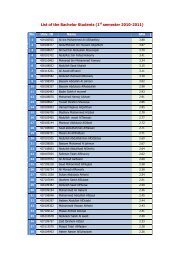
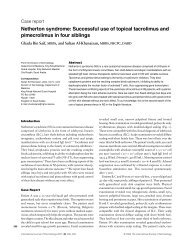
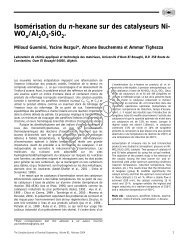
![التجربية الأولي [Read-Only] - KSU](https://img.yumpu.com/15502211/1/190x135/-read-only-ksu.jpg?quality=85)
